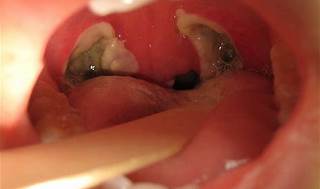A nurse is caring for a school age child who is 1 hour postoperative following a tonsillectomy.
Which of the following actions should the nurse take?
. Discourage the child from coughing
Provide cranberry juice to the child
Maintain the child in a supine position
Administer an analgesic to the child on a schedule basis
Correct Answer : A

The correct answer is choice a. Discourage the child from coughing.
Choice A rationale:
Discouraging the child from coughing is important because coughing can dislodge clots and cause bleeding at the surgical site, which is a common complication after a tonsillectomy.
Choice B rationale:
Providing cranberry juice to the child is not recommended because acidic juices can irritate the throat and cause discomfort or pain.
Choice C rationale:
Maintaining the child in a supine position is not ideal as it can increase the risk of aspiration. Instead, the child should be positioned on their side or with the head elevated to facilitate drainage and reduce the risk of aspiration.
Choice D rationale:
Administering an analgesic to the child on a scheduled basis is important for pain management, but it is not the most immediate action to take one hour postoperatively. Pain management should be part of the overall care plan.
Nursing Test Bank
Naxlex Comprehensive Predictor Exams
Related Questions
Correct Answer is C
Explanation
Answer is choice C.
Choice A rationale: The rationale for Choice A involves understanding the principles of mobilization and rehabilitation following the application of an arm cast. While it is essential to limit strenuous activities involving the affected arm to prevent further injury or displacement of the fracture, completely immobilizing the fingers of the broken arm can lead to joint stiffness, muscle atrophy, and impaired circulation. Encouraging the client to move the fingers and elbow within the limits of comfort and physician instructions helps maintain joint mobility, prevent contractures, and promote blood flow, supporting the overall healing process.
Choice B rationale: Statement B pertains to the expected course of swelling following the application of an arm cast. While mild swelling is a common immediate response to trauma or immobilization, persistent or worsening swelling may indicate underlying complications such as compartment syndrome, vascular compromise, or infection. Monitoring and managing swelling are crucial aspects of post-cast care to prevent complications and ensure optimal healing outcomes. Therefore, expecting fingers to remain swollen for several days without further assessment or intervention may overlook potential issues requiring medical attention.
Choice C rationale: Elevating the broken arm on pillows at night is a fundamental aspect of post-cast care aimed at reducing swelling and promoting comfort and healing. Elevating the affected limb above the level of the heart helps enhance venous return and lymphatic drainage, thereby minimizing edema and alleviating discomfort associated with swelling. Additionally, maintaining proper elevation during periods of rest supports tissue perfusion and facilitates the resolution of inflammation, contributing to the overall recovery process. By expressing intent to elevate the arm on pillows at night, the client demonstrates comprehension of an essential self-care measure conducive to optimal healing and rehabilitation.
Choice D rationale: The statement regarding sprinkling baby powder into the cast if the arm itches reflects a misunderstanding of appropriate cast care practices. Introducing foreign substances, such as powders or objects, into the cast can create a conducive environment for bacterial growth, increase the risk of skin irritation or infection, and compromise the structural integrity of the cast. Instead of using powders, clients are advised to employ non-invasive techniques to alleviate itching, such as gently tapping or blowing cool air into the cast or seeking medical guidance for alternative solutions. Encouraging adherence to recommended cast care protocols helps minimize complications and promote favorable outcomes during the healing process.
Correct Answer is C
Explanation
Choice A rationale
Prolonged headache is not typically identified as a common trigger for seizures. While headaches can be associated with certain types of seizures, they are not generally considered a trigger for seizure activity.
Choice B rationale
Decreased temperature, or hypothermia, is not typically identified as a common trigger for seizures. In fact, fever or increased body temperature is more commonly associated with triggering seizures, particularly in children.
Choice C rationale
Lack of sleep is a well-recognized trigger for seizures. Sleep deprivation can lead to increased seizure frequency in individuals with epilepsy. Ensuring adequate sleep is an important part of managing seizure disorders.
Choice D rationale
Exposure to second-hand smoke is not typically identified as a common trigger for seizures. While it is generally harmful to health, it is not specifically associated with an increased risk of seizures.
Whether you are a student looking to ace your exams or a practicing nurse seeking to enhance your expertise , our nursing education contents will empower you with the confidence and competence to make a difference in the lives of patients and become a respected leader in the healthcare field.
Visit Naxlex, invest in your future and unlock endless possibilities with our unparalleled nursing education contents today
Report Wrong Answer on the Current Question
Do you disagree with the answer? If yes, what is your expected answer? Explain.
Kindly be descriptive with the issue you are facing.
